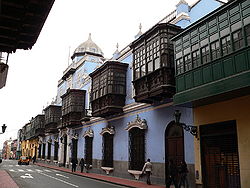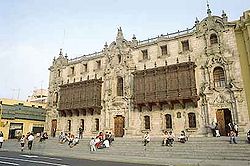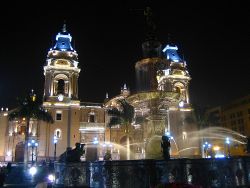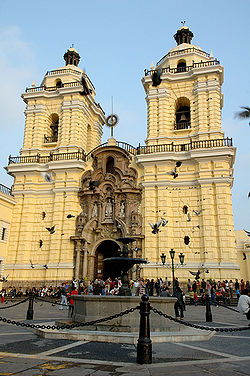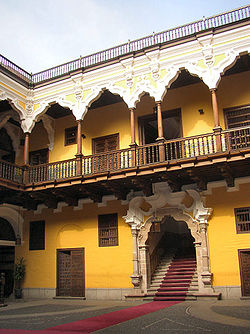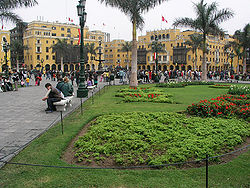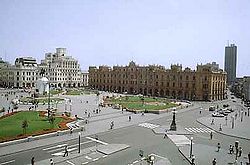Historic Centre of Lima
| Historic Centre of Lima* | |
|---|---|
| UNESCO World Heritage Site | |
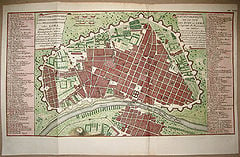
| |
| State Party | |
| Type | Cultural |
| Criteria | iv |
| Reference | 500 |
| Region** | Latin America and the Caribbean |
| Inscription history | |
| Inscription | 1988 (12th Session) |
| Extensions | 1991 |
| * Name as inscribed on World Heritage List. ** Region as classified by UNESCO. | |
The Historic Centre of Lima is the portion of the city of Lima, Peru founded in 1535 by Spanish conquistador Francisco Pizarro as La Ciudad de los Reyes, or "The City of Kings." It became the most important city in the Spanish Viceroyalty of Peru, established by Charles V in 1542, and remained so for two centuries.
Numerous buildings in the old city, such as the Convent of San Francisco (the largest of its type in this part of the world), are the result of collaboration between Native and Old World craftsmen. Lima's historic center was declared a UNESCO World Heritage Site in 1988, for its originality and high concentration of historic monuments constructed in the time of Spanish presence. It is one of the most important tourist destinations in Peru.
Foundation
The city of Lima, the capital of Peru, was founded by Francisco Pizarro on January 18, 1535 and given the name "City of the Kings". Nevertheless, with time its original name persisted, which may come from one of two sources: Either the Aymara language lima-limaq (meaning "yellow flower"), or the Spanish pronunciation of the Quechuan word rimaq (meaning "talker", and actually written and pronounced limaq in the nearby Quechua I languages). It is worth noting that the same Quechuan word is also the source of the name given to the river that feeds the city, the Rimac river (pronounced as in the politically dominant Quechua II languages, with an "r" instead of an "l"). Early maps of Peru show the two names displayed jointly.
The period of colonialism in South America was a time of magnificence and grandeur. Buildings were created as works of art.
A disastrous earthquake in 1656 destroyed many of the original structures in Lima. Reconstruction was begun the following year, much of it undertaken by Portuguese architect Constantino de Vasconsellos. His protégé, Lima-born Manuel de Escobar later succeeded him in the task.
Balconies of Lima
Lima is well-known for its balconies — more than 1,600 — that were built in the viceroyalty era as well as during the republic. The abundance of these balconies adds to the particular harmony and originality in this part of the city.
The Municipality of Lima has adopted a system of "balcony adoption", giving both individuals and companies the opportunity to personally maintain a historic piece of the city.
Principal Monuments
Archbishop Palace
see Archbishop's Palace of Lima
The Archbishop Palace is the home of the Archbishop of Lima. It is a popular tourist attraction in the Historical centre of Lima, Peru. The first major church began construction in 1535. Pope Paul III turned it into an episcopal seat in 1541. In 1547, Lima was elevated to an archdiocese, which turned it by a short period, in the more extensive ecclesiastical circumscription of the world. The patron of the episcopal seat is Saint Rosa of Lima.
House of Aliaga
This house was constructed in 1535 on a pre-columbian sanctuary. It was constructed on the date, that is shared with that of the foundation of the city, it has been inhabited permanently by the descendants of the first proprietor, Jerónimo de Aliaga, standard-bearer for Francisco Pizarro. One is the oldest mansion of the city and one is in front of the Government Palace, in a lateral street. Their halls, extensive and luxurious and their inner patio, have all the characteristics of the most important mansions of the historical center of Lima of the viceroyal time. Given the perfect state of conservation, in special circumstances, this mansion usually shelters certain cultural events.
House of Oidor
In this house, one of oldest of the city, lived the Oidor, that was named by the Spanish monarchy to act in the colonial administration. The Oidor had by functions to cross the administered territory to control its government. In this sense, it advised to the viceroy as a consultant.
House of Pilatos
This is one of the oldest houses of Lima, constructed in 1590 by a Jesuit priest called Luis Opening. The name of this large house was given by the Spaniards who arrived and stated the similarity of the house with one in Seville.
Goyeneche House
This is one of the most outstanding houses of the historical center, constructed in the middle of the eighteenth century with French influence. One is in its original state with its balconies a typical characteristic of colonial Lima.
Riva Agüero House
This house was constructed in the eighteenth century by the Riva Agüero family, whose last member, the intellectual Jose of the Riva Agüero, donated it to the Pontifical Catholic University of Peru. At the present time Agüero is used like headquarters of the Riva Institute, conserving an interesting historical file and a library being simultaneously used by the local Museum of Popular Art of the PUCP.
Basilica Cathedral
The Basilica Cathedral of Lima, which has become one of the main symbols of the city, started construction the same year the city was founded; 1535. Since then there have been numerous remodilations. The Cathedral of Lima displays a form architecture that makes it unique in all of South America, of the style of the viceroyal time. The benches of the cathedral are of the finest quality as well are the of the benches of their Choir. The Greater Altar is covered with gold bread and has images of the viceroyal time. Within the Cathedral, are the ashes of the founder of the City of the Kings, today City of Lima, Francisco Pizarro. Every year, in the month patriotism, is celebrated the mass Te Deum in gratefulness by the independence from Spain. A custom retaken by the Cardinal Juan Luis Cipriani, is to give the mass all Sundays at 11:00 a.m. In 2005 the current mayor of Lima, Luis Castañeda Lossio, created the project of illuminating the cathedral with new lights.
Basilica of Our Lady of the Rosary and Convent of Santo Domingo
It took more than five decades delay for the construction of the church and the Convent of Santo Domingo, because the project begun at the same time as the foundation of Lima and the end of the sixteenth century marked by the end of it. The church is composed by three naves with a carved choral ashlar masonry in cedar wood. The church is crowned by a large cuple. The interior displays images from the first years of the City and also an image of Our Lady the Virgin of the Rosary, which first arrived at the Rímac Valley, Patron of the city, has deep relation with the Peruvian saints and by its remarkable devotion that was coronated in the year 1927 in a unique event in the religious history of the country. On the other hand, the convent, like all, has interesting claustros and in this case, with Sevillian style patios their typical tiles. Its capitulary room is of the baroque style. It is here, in 1551, that the National University of San Marcos was founded, the first in the Americas. The temple of Our Lady of the Rosary (original name of the church of Santo Domingo) was elevated to the category of basilica in 1930, and in its interior is the Altar of the Peruvian Saints, which is visited annually by thousands of residents of Peru and by many foreigners.
Basilica and Convent of San Francisco
This architectonic complex was constructed in the seventeenth century and is made up by the church and the convent of San Francisco, as well as of the chapels of the Solitude and the Miracle. During your visit their claustros can be appreciated, their patios adorned with Sevillian tiles and the library. Here it is the headquarters of the Museum of Religious Art and the Zurbarán Room. Under this complex there is a network of underground galleries and catacombs that were a cemetery at the colonial time and which are also very much visited.
Merced Church
The Church of Merced was constructed in eighteenth century with a churrigueresco style; appreciating it as much external as internally, the visitor occurs an idea of the splendor of the architecture of the time. In this church, full of works of art there is an emphasis on the greater altar in honor to the Virgin of Mercedes and one sacristía with arabesque tiles. Here it is possible to see one of the decks of collections of paintings and colonial statures of the city. The Virgin of the Mercedes is the patron of the Arms of the nation.
Sanctuary and Monastery of Las Nazarenas
Sanctuary where is venerated main Peruvian catholic devotion Lord of Miracles, Señor de los Milagros, who is Patron of the city. It was constructed together with Monastery of Nazarenas nuns in eighteenth century, after a hard earthquake in 1746.
Basilica of San Pedro
Main church of Society of Jesus in Peru, it was constructed in 1638 as Church of San Pablo Apóstol. In 1767 it was called San Pedro.
Government Palace
The Government Palace is the residence of the President of the Republic. Its original name is the House of Pizarro but informally it is designated to him like the Palace of Government.
Torre Tagle Palace
The Palace of Torre Tagle probably is the most significant mansion built at the beginning of the eighteenth century. Initially it belonged to Don Bernardine Jose of Tagle Portocarrero, fourth and last Marquess of Torre Tagle. The Peruvian state acquired it in 1918 and from 1919 it is the main headquarters of the Ministry of Foreign Affairs of Peru. It is made of artistic Limean architecture which describes its originality and also demonstrates the racially mixed contributions of the Viceroyalty of Peru, fitting them together harmoniously. It has a carved stone cover and two balconies, that are authentic jewels of the City of the Kings. One is in perfect state of conservation.
University Park
This park was constructed in 1870. In 1921 the park was located in where the cultural Center of the National University of San Marcos now stands. In the occasion of the centenary of the independence of the nation, the German colony arranged to construct the 30 meter Tower of the Clock. At noon, their bells touch notes of the national anthem.
Plaza Mayor
The Plaza Mayor is at the exact location where Francisco Pizarro founded Lima. In this plaza some of the most excellent facts of the history of the country have been developed. Initially, there were small stores and commerce. Also, it was the scene of in excess of bulls and served like the site of execution of the condemned until death by the Court of Santa Inquisición. In 1651, a bronze battery was placed in the center of the seat that lasts to date. It was in the Plaza Mayor where it was proclaimed, in 1821, the Act of Independence of Peru. It is surrounded by the Palace by Government, the Municipality of Lima, the Cathedral and the Archbishop's Palace.
Plaza San Martin
This plaza was inaugurated in 1921 in the occasion of the centenary of the Independence of Peru. In the central part, there is a monument in honor of general José de San Martín. It was built by the Catalán sculptor Mariano Benlluire. In this plaza of important buildings, the ex- hotel Bolivar stands, who until the new millennium, was most elegant of Lima, as well as the Club Nacional, the watering hole for Lima's high society. The plaza has become one of the many symbols of Lima.
Court of Santo Oficio
The Court of Santo Oficio was established in 1569 with the purpose of sanctioning heresies and other crimes against the Catholic faith. Its abolition dates from 1820. On the external part of this monument it is possible to see an imposing neoclassic porch and, in the main hall, an outstanding carved wood ceiling, which is considered best in the city.
External links
- Article in the Spanish newspaper ABC about the House of Aliaga Spanish
- About the Historical Center Spanish
- Religion in the City of the Kings of Peru Spanish
- 360° view of Lima Main Square
| |||||||
Credits
New World Encyclopedia writers and editors rewrote and completed the Wikipedia article in accordance with New World Encyclopedia standards. This article abides by terms of the Creative Commons CC-by-sa 3.0 License (CC-by-sa), which may be used and disseminated with proper attribution. Credit is due under the terms of this license that can reference both the New World Encyclopedia contributors and the selfless volunteer contributors of the Wikimedia Foundation. To cite this article click here for a list of acceptable citing formats.The history of earlier contributions by wikipedians is accessible to researchers here:
The history of this article since it was imported to New World Encyclopedia:
Note: Some restrictions may apply to use of individual images which are separately licensed.
